Camping in bear country can be a little intimidating, especially for newbie campers. We put off taking our kids to Yosemite for years because we just weren’t sure how safe we’d be roughing it alongside these furry neighbors. Now that we have five major road trips in bear country under our belts, we don’t even give it a second thought. We know that as long as we follow a few simple guidelines for interacting with wildlife, we’ll be safe. Since we get so many inquiries on this particular subject, we thought we’d answer a few of your most asked questions about taking a pop up camper into bear country.
Are pop up campers allowed in Yellowstone?
YES! You absolutely can camp in Yellowstone in a pop up camper. This is our number one most frequently asked question about camping in bear country. There seem to be nasty rumors floating around that pop up campers aren’t allowed in Yellowstone… or Glacier… or Yosemite. That is simply not correct. Now, it is true that there are a select few campgrounds in some national parks–for example Fishing Bridge in Yellowstone–where only hard-sided campers are allowed. This is usually due to grizzly bear activity in the area, but that doesn’t mean that there aren’t other amazing campgrounds in those parks where pop up campers can set up camp. 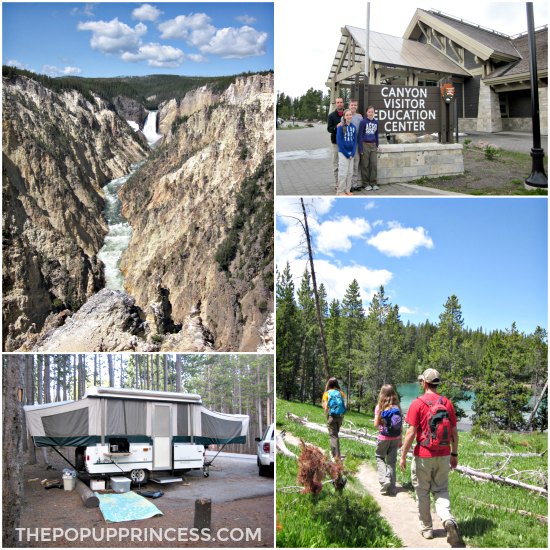
We stayed in Canyon Campground during our visit to Yellowstone, for example, and it was perfect for our needs. While we did see a grizzly bear in the campground (more on that below), it ended without incident and remains a fond memory today. Check the campground’s website before you make your reservations, as they usually have very detailed information online about camping restrictions in the area.
How do you store your food when camping in bear country?
Proper food storage is essential to safely camping in bear country. We don’t store any food in our camper. Bears–especially the ones in the Sequoia and Yosemite area–are resourceful and will think nothing of ripping through your camper canvas to get to the food they smell. That’s why campsites in those areas provide bear boxes for food storage in each campsite. These special metal boxes are designed to be impenetrable to bears. If you aren’t camping in a hard-sided RV, park regulations in those parks will require you to store all food and other scented items in the designated bear boxes.
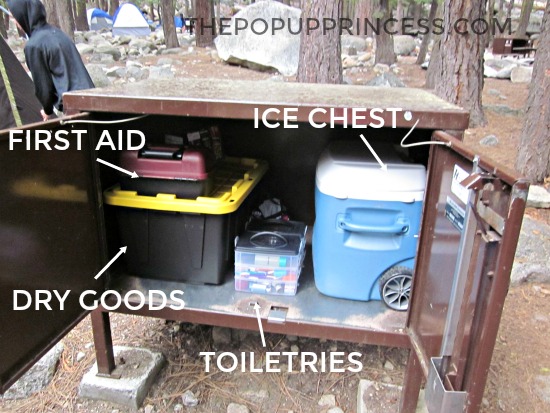 These boxes are usually large enough to accommodate quite a bit of food and gear. You can see how large our bear box at Sequoia National Park was in the above photo. The measurements of a campground’s bear boxes are usually available online, and you can find them when you make your site reservations. Pay special attention to these measurements, as not all bear boxes are created equal. We found this out the hard way on our first trip to bear country. When we were on the Sequoia trip, we hit Yosemite National Park a few days later. We expected our supplies to fit the the bear box in much the same way. The Yosemite bear boxes were considerably smaller, and we had to make a run back into town to purchase a smaller ice chest to hold our cold items. Lesson learned. 🙁
These boxes are usually large enough to accommodate quite a bit of food and gear. You can see how large our bear box at Sequoia National Park was in the above photo. The measurements of a campground’s bear boxes are usually available online, and you can find them when you make your site reservations. Pay special attention to these measurements, as not all bear boxes are created equal. We found this out the hard way on our first trip to bear country. When we were on the Sequoia trip, we hit Yosemite National Park a few days later. We expected our supplies to fit the the bear box in much the same way. The Yosemite bear boxes were considerably smaller, and we had to make a run back into town to purchase a smaller ice chest to hold our cold items. Lesson learned. 🙁
What about toiletries and cleaning supplies?
Everything from toothpaste to dish soap needs to be stored in the bear box. Bears don’t differentiate between food and deodorant. Anything that smells like food will attract them, so make sure you stash your toiletries in the bear box as well. We use these stack and carry containers to store our toiletries in bear country. Each family member gets a compartment, and they are easy to carry back and forth to the bathrooms. Dish soap and sani-wipes go in resealable bags in our dry goods tote.
What if are no bear boxes in the campground?
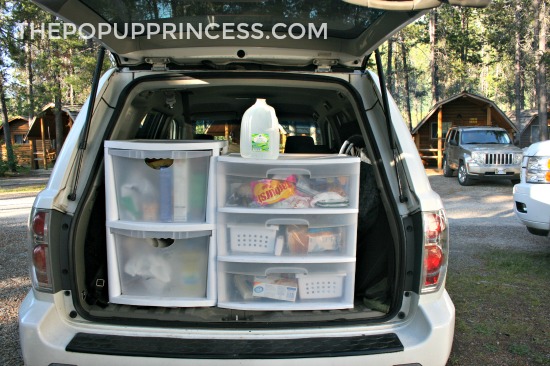 It is true that some campgrounds don’t provide bear boxes in each site. When we camped in Yellowstone and Glacier, there were a few bear boxes scattered throughout the campground, but no site specific ones. In both cases, we were allowed to store food and scented items in our vehicle. This absolutely would not have been allowed in Yosemite, as the bears in that area have become conditioned to finding food in cars. While it would be virtually unheard of today, in the early 1900’s, feeding bears in the Yosemite area was quite popular. This meant bears became accustomed to finding their next meal in the campground dumpster or in tourists’ cars. They know what ice chests look like and what they’ll find inside.
It is true that some campgrounds don’t provide bear boxes in each site. When we camped in Yellowstone and Glacier, there were a few bear boxes scattered throughout the campground, but no site specific ones. In both cases, we were allowed to store food and scented items in our vehicle. This absolutely would not have been allowed in Yosemite, as the bears in that area have become conditioned to finding food in cars. While it would be virtually unheard of today, in the early 1900’s, feeding bears in the Yosemite area was quite popular. This meant bears became accustomed to finding their next meal in the campground dumpster or in tourists’ cars. They know what ice chests look like and what they’ll find inside.
National Parks like Yellowstone and Glacier have been more successful in keeping their bears wild. In those national parks, you must still be very careful about food and scented item storage, but it is less likely that bears in those areas will tear apart your vehicle to get to an enticing smell. That’s why we were able to keep our food and toiletries in the car when we visited those parks. Make no mistake! There are still bears in the area, and you’ll still have to be vigilant about properly storing scented items.
How do you handle trash and gray water?
You should always appropriately dispose of trash before leaving your site or going to bed for the night. These items also smell like food to bears, so it is essential to keep a clean campsite. Most campgrounds have designated bear-proof trash receptacles in every loop. If your trash bag isn’t quite full enough for the dumpster, you should store it in the bear box or your vehicle until it you are ready to throw it away. Don’t ever leave trash unattended in your campsite.
The same rules apply to gray water. In some of the heavily frequently national parks, there are specific indoor comfort stations for washing dishes and disposing of waste water. Familiarize yourself with the location of these sites, and make sure to properly dispose of all waste before leaving your site. You don’t want to attract any unwanted visitors while you are away… or asleep. 😉
Can we use our cassette toilet in bear country?
You should always ask the park rangers at check-in whether it is allowed. Every park is different. In most parks we’ve stayed in, we’ve been told it was fine. We made sure to dump our cassette tank frequently. Of course, you should check with the rangers to find out the appropriate place to dispose of that black water waste in each campground. Every site is different. I like having our potty available as an alternative to traipsing through the woods in the middle of the night–prime bear activity time–and we have never had a problem using it on our travels. For more tips on using your cassette toilet, be sure to read this post.
How do you hike with your kids in bear country?
Honestly, hiking with our kids in bear country isn’t much different than hiking anywhere. The key to hiking in bear country is making lots of noise. Like most kids, ours do that really well. 😆 The majority of bear attacks happen when a bear has been startled and feels the need to defend himself. If you make enough noise to allow the bear time to avoid you, he probably will. Singing, playing games of I Spy, and telling stories not only keep our kids occupied while we are trekking in the forest, but they also give the wildlife enough notice to get our of our path.
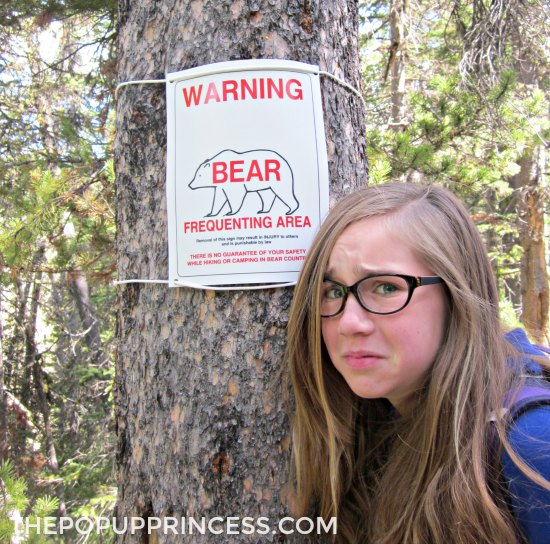 You should, however, check in at the visitors’ center or trail head to see if there have been bear sightings on the path before you attempt to hike it. Yellowstone was great about giving campers plenty of warning signs when a bear had been spotted in the area. In Sequoia, returning hikers would often pass along news of bear sightings as well. Most of the time, it doesn’t mean you can’t hit the trail, only that you do so at your own risk. We always make our decision based on the type of bear and the nature of the sighting. If a small black bear was seen off in the distance–as was the case in the picture below–we would often continue with our plans. Brown bears can be a little more unpredictable, and we haven’t been willing to take the risk if one was sighted nearby.
You should, however, check in at the visitors’ center or trail head to see if there have been bear sightings on the path before you attempt to hike it. Yellowstone was great about giving campers plenty of warning signs when a bear had been spotted in the area. In Sequoia, returning hikers would often pass along news of bear sightings as well. Most of the time, it doesn’t mean you can’t hit the trail, only that you do so at your own risk. We always make our decision based on the type of bear and the nature of the sighting. If a small black bear was seen off in the distance–as was the case in the picture below–we would often continue with our plans. Brown bears can be a little more unpredictable, and we haven’t been willing to take the risk if one was sighted nearby.
Have you ever seen a bear while camping or hiking?
We have! Many times, actually. Our favorite way to view wildlife is either from the car or from a safe distance several hundred yards away. That allows us to observe them at our leisure and snap a few pictures our for memory book. As a mother, I’m also most comfortable knowing there is a sizable distance between the bear and my babies, but we have had a few close encounters with wildlife on our adventures.
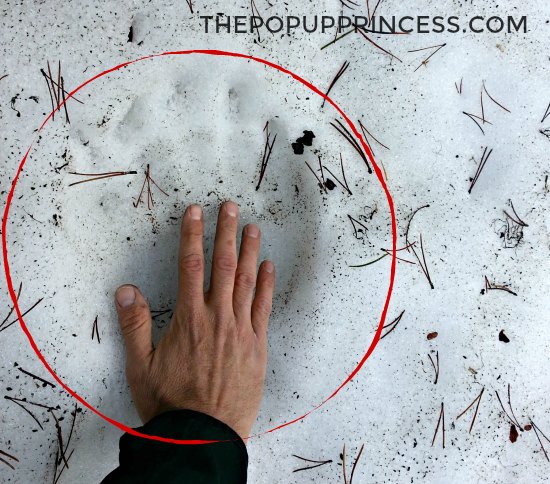 In fact, while camping in Yellowstone a few years ago, a huge grizzly bear actually walked through our camp. We were visiting in late May, and Canyon Campground had just opened for the season. The local wildlife was pretty accustomed to having free reign of the place. We arrived at camp, set up the pop up, and started making sandwiches on the picnic table. Mr. TypeTwoFun heard a noise, looked up, and a large grizzly was making his way through our site. We grabbed what food we could and slowly made our way to the car behind us. Thankfully that grizzly didn’t give us a second thought.
In fact, while camping in Yellowstone a few years ago, a huge grizzly bear actually walked through our camp. We were visiting in late May, and Canyon Campground had just opened for the season. The local wildlife was pretty accustomed to having free reign of the place. We arrived at camp, set up the pop up, and started making sandwiches on the picnic table. Mr. TypeTwoFun heard a noise, looked up, and a large grizzly was making his way through our site. We grabbed what food we could and slowly made our way to the car behind us. Thankfully that grizzly didn’t give us a second thought.
We didn’t get to snap any pictures of him, as we were all pretty terrified. We did manage to find his tracks later in the snow around our campsite. That is Mr. TypeTwoFun’s hand for comparison. That bear was enormous, and I’m so glad he was uninterested in us. It could have gotten really scary really fast. We reported him to the rangers so they could keep an eye out for him, but we didn’t see him again during our stay.
What should you do if you encounter a bear?
First and foremost, remain calm. Every bear is different, which means every bear encounter will be different. There are a few universal strategies we’ve learned from park rangers, though, that can prevent the situation from escalating.
- Identify yourself. Let the bear know you are human by calming talking and slowly waving your arms. You want him to see you as a human and not a prey animal.
- Stay calm and stand your ground. Screams and sudden movements, such as running away, may trigger an attack. Continue to talk to the bear in low tones, so as not to be threatening to him.
- Make yourself look larger and pick up small children immediately.
- Hike in groups and make lots of noise. This will help alert the bear to your presence.
- Do not drop your pack or allow the bear access to your food. You may need your pack for protection should the situation escalate.
- Carry bear spray if possible. Bear spray can be an effective defense tactic to use against an aggressive bear. If possible, you should always carry it when hiking in bear country and learn how to properly use it.
- Leave the area or take a detour if possible. And always allow the bear an escape route.
For more information on any of these strategies and additional bear encounter tips, visit the National Parks Service’s Bear Safety Page. There is some fantastic information there that will help you plan a memorable trip to one of the amazing national parks in bear country.
I am so glad we didn’t let our fears prevent us from visiting these amazing places. We’ve made some of our best memories in bear country. We’re always looking for new places to visit, so we’d love to hear where some of your favorite spots to camp are. Got any tips you’d like to share? Feel free to comment below. 🙂
Happy Camping!







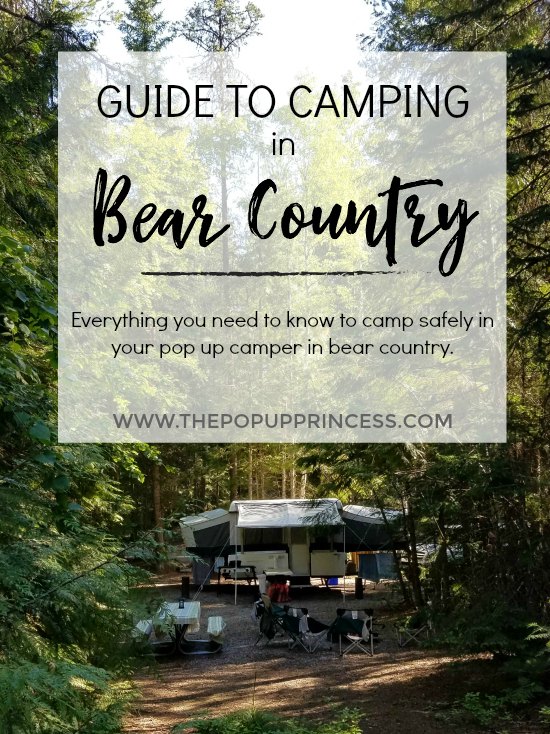
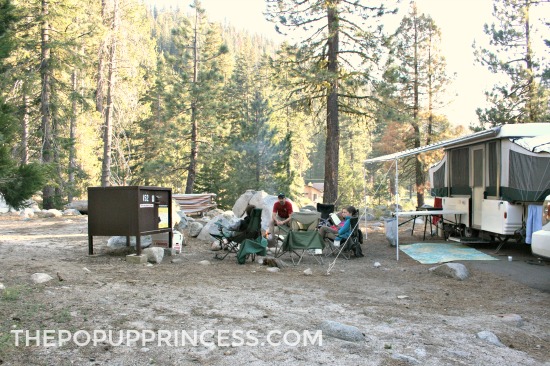
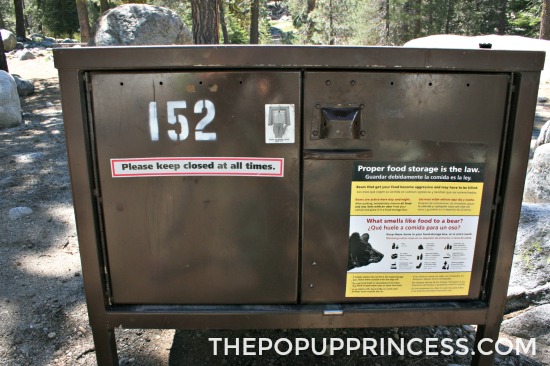
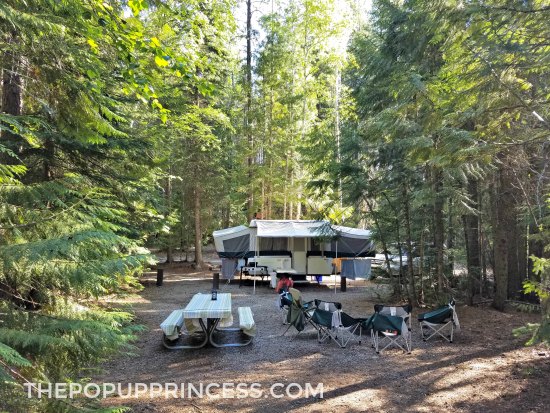
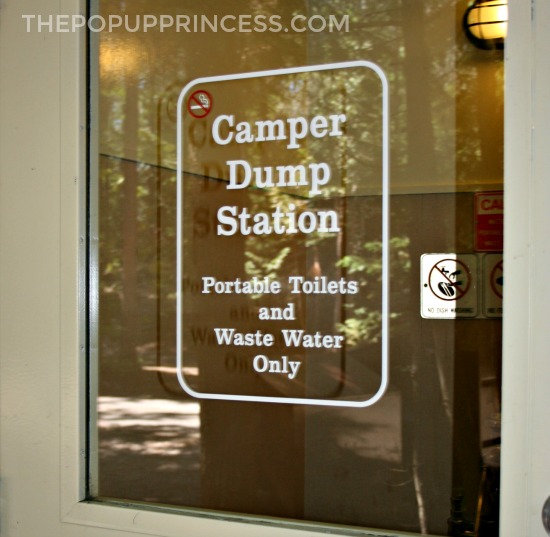
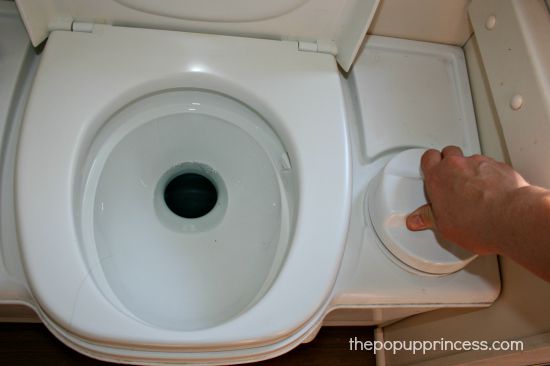
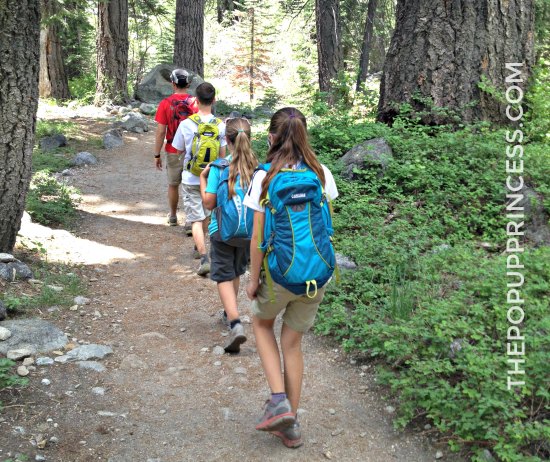
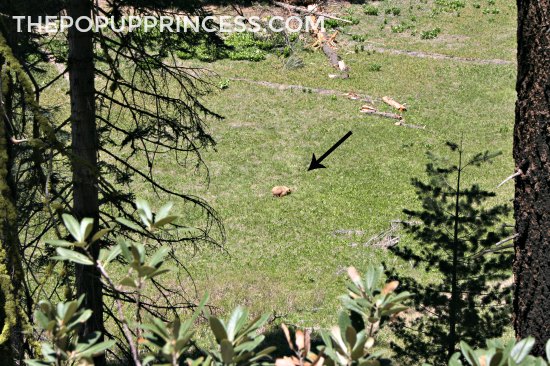
Thanks for the great info! We’re planning our first camping trip to bear country this summer so this topic was on my mind. One question though: do you still use the propane cooktop on the outside of the camper, or do you try to do your cooking farther away from your camper? We have a coleman camping stove we can use instead, but the pop up stove is so much more convenient! Thanks
Great question! We use a slightly larger Camp Chef stove, Kristen. We have used the camper stove outside (attached to the camper) in bear country before. When we use it, we try to make non-messy meals there, so as not to splatter food on the canvas. I much prefer using the portable stove away from the camper, but either way, when we are done cooking, we give everything a good wipe down to remove any lingering food scents. If we are bringing the smaller stove, we stash in it the bear box. 🙂
Thank you for the tips! We are spoiled in Ohio, where coons are the biggest food/trash grabbers. But we have often talked about taking our pop up to some wilder places lol! I really appreciate this post as well as your others!
Do you suggest not keeping food in the minifridge inside the pop up?
We keep a little food inside the fridge when we are not camping in bear country. You just have to make sure you clean it out really well in between trips. 🙂
What about pans and utensils – can you put those back in the camper, or should you put those in a bearbox or your car? Thanks for all the good info!
If we have cleaned everything really well, I will put it back in the camper. We keep the dutch oven and propane stove in the car or bear box, though.
If we have previously cooked in the popup do we need to do something to nueturalize smell of food in popup.?
I would just clean it really well between trips, Cindy. We’ve cooked in the PUP before out of necessity, and we have been fine. Over time smells dissipate anyway. Just don’t cook anything like bacon that would leave grease spatters on the canvas. 😀
Awww Yosemite, love it!! Don’t forget to double check for candy the kids might stash in pockets and bedding. Also a reminder, get everything unscented/unflavored, like chapstick or lip balm, we tend to put those in our pockets/jackets and the bears like those also.
What do you use to wipe down after cooking? I know some cleaning product attract bears too. Thanks!
Thanks for all of the great info. We’re camping in Sequoia National Park/Lodgepole in a few weeks. We’ve checked the bear box dimensions online and it looks like our ice chests might be a tight fit. Any chance that you could tell me the size of your black container with yellow lid from the photo of everything packed in the bear box? We have a few of them that are the 27 gallon size from Costco. Wondering if what you have pictured is the same box so we can compare the size to our ice chests. Thanks so much!
Yep! Those are the standard 27 gallon totes from Costco. 😉
Have a great time in Sequoia. We loved our time there. If you missed it, you can read about our adventures in Lodgepole here.
Great! We should have a good tetris-style fit for all of our food in the bear box. We’re looking forward to camping and exploring in the area and your post highlighting your adventures was a great resource for our planning. Thanks!
What about cooking on the pop up and all the utensils and pots and pans?
We never cook in our pop up camper. We’ve always cooked outside. Once the utensils and such are clean, we store them back in the camper. All food goes in the tow vehicle, though.
We are planning our first trip to Yellowstone and had hoped to car camp in our SUV. Is this an option anywhere? From what I am reading, it seems like it may not be?
I don’t see why not. There were lots of tent campers in Canyon Campground when we were there, Kristin! 🙂
Hi Larissa,
I’ve followed your blog over the past couple years and so when I was searching for information on PUP camping in Yellowstone, I was excited to find this post.
My question is a little different – not about bear safety and food smells. It’s about the size of the site. We have a very similar Flagstaff PUP and are looking to reserve at Canyon this July. Most sites say max 20’ or 30’ trailer + toad.
What size spot did you reserve, and do you have any recommendations to share?
Thank you so much for all your great information!
Jess from California
We stayed in site #117 in Canyon Campground. When we made our reservations, though, we just told them our overall length and they assigned a site that would work for us. We weren’t able to select individual sites back then. We haven’t been to Yellowstone since, so I don’t know if that has changed. We were an overall length of 30′ at the time, and it was still a tight squeeze. You can read all about our Yellowstone trip here. 🙂
We will be camping with our pop up in Yellowstone, grand Teton and glacier this summer. Can we sore food in the fridge inside the camper? Can we cook on the outside stove as long as we wipe it down right after? What about the gray water tank from the sink or should we not even use water inside the camper? Thanks and loved all your info!
I would check with the campground hosts and rangers where you are staying and ask what they recommend. Our gray water tank is outside of our camper. When we visited Yellowstone and Teton, we were told we could wash dishes inside as long as we emptied the tank each time we left (or went to bed) and stored the tank itself in the bear box. We were told not to keep food in the fridge, though.